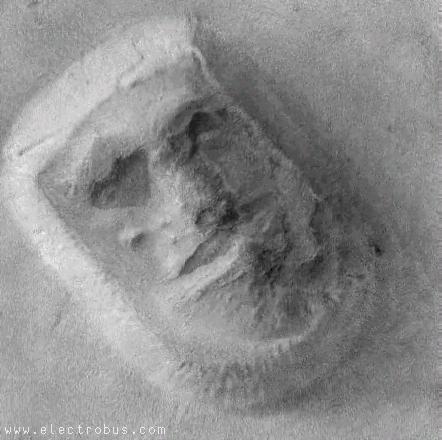Europa Reveals More of Her Secrets -
Hoagland Confirmed Again

UCLA scientists, in a new paper to be published in the journal Science, have concluded that oscillations in the magnetic field of Jupiter's moon Europa can only be caused by an electrically charged layer beneath the moons icy crust. Magnetometer results from the January 3, 2000 Galileo flyby show that Europaís constantly fluctuating magnetic field completely flip-flops every 5.5 hours in response to the rocking motion of Jupiterís own magnetic field. Although exotic materials such as graphite could account for the results, the most likely explanation for this is a salty liquid water ocean, perhaps as close as 4.7 miles beneath the ice crust.
Both of these results are to be expected if the models put forth by Cassen, Reynolds, and Peale in 1977 and Enterprise principal investigator Richard C. Hoagland in 1980 are correct. Cassen et. al had predicted that tidal stresses on Europa from Jupiter's intense gravitational field could produce sufficient warming beneath the ice to create a liquid water ocean. Hoagland, after observing the Voyager flyby of Europa at JPL in 1979, took this concept further and argued not only must there be an ocean beneath the crust, but that Europa had possessed all the essential building blocks of life well before that ocean had frozen over. In a paper published in the magazine Star and Sky, "The Europa Enigma," Hoagland went on to propose that volcanic rifts in the ocean floor (much like those found on Earth) would almost certainly contribute further to the "organic soup" required for life and that with 4 billion years of evolution below the ice, very complex life forms might be found on present day Europa. He was the first to propose that dark fissures in the surface crust of Europa were caused by the seepage of organic materials from this deep seated ocean.
At the time, these ideas were roundly criticized and dismissed, except for a very few members of the scientific community. Arthur C. Clarke and Dr. Robert Jastrow -- one of the founders of NASA, and former Director of its Goddard Institute for Space Studies, both embraced the idea. Based on Hoagland's startling theory, Clarke two years later would create a sequel to his most famous work ("2010: Odyssey Two" -- after long claiming that such a follow-on was "impossible"). This would then be followed by a movie sequel (co-written and directed by Peter Hyams) of the same name. As Clarke put at the time in the acknowledgments to "2010:"
"The fascinating idea that there might be life on Europa, beneath ice-covered oceans kept liquid by the same Jovian tidal forces that heat Io, was first proposed by Richard C. Hoagland in the magazine Star & Sky ( The Europa Enigma,' January, 1980). This quite brilliant concept has been taken seriously by a number of astronomers (notably NASA's Institute of Space Studies, Dr. Robert Jastrow), and may provide one of the best motives for the projected GALILEO Mission..."
Now, twenty years later, even NASA's most ardent Hoagland haters are being forced to admit that Hoagland's overarching model of Europa -- which included over 20 years ago some kind of highly evolved, living organism's potentially swimming in that ocean -- is almost certainly correct. So, having failed to disprove his two-decade-old theory (in fact, just the contrary!), some critics have now desperately launched a full blown, rear-guard attempt to remove Hoagland from his historically preeminent position on this issue, as it has become clearer with each Galileo fly-by of Europa over the past several years that his startlingly original scientific model of Europa is inexorably being confirmed.
These desperate, last-ditch efforts have even included recent charges of outright fraud -- bizarre claims that Hoagland has attempted to take false credit for Cassen, Reynolds and Peale's original published work on the Europan tidal stresses. In fact, from the beginning, Hoagland specifically cited their preceding pioneering work, using it as the credited foundation for his own meticulously worked out biological model of what might be occurring in that ocean, in "The Europa Enigma" itself. Which, decades later, he would update on the Enterprise web site.

As we get closer to NASA's in-depth testing of the rest of Hoagland's Europa theories (via new Europa missions themselves), including the content of that dark material staining the surface of Europa's ice, expect these disinformation efforts to dramatically increase. While Europa will wait for no man in her rush to reveal her secrets to these new robotic surrogates from Earth, there are plenty of consequences for those that would seek to obscure the truth. By all means, as these people see it, Hoagland must not be allowed to receive appropriate credit for his successful Jovian (and other ...) scientific predictions. For if that happened, some in the media (and inside NASA!) might just take seriously his multi-disciplinary work on another interesting piece of Solar System real estate ...

Rest assured however, that we will not let these efforts succeed.